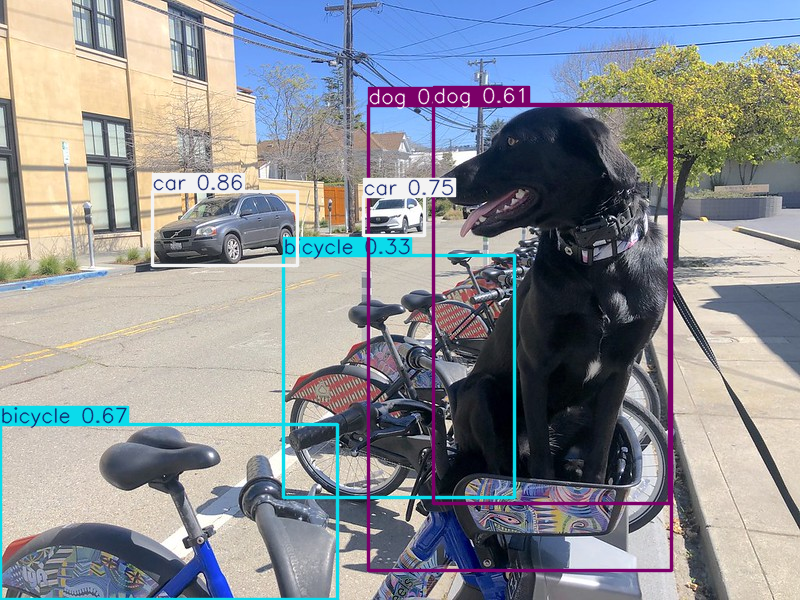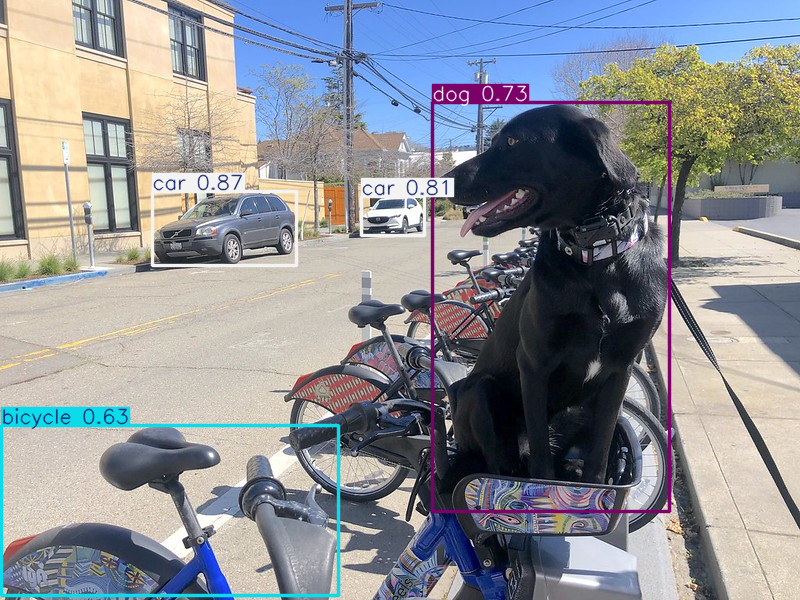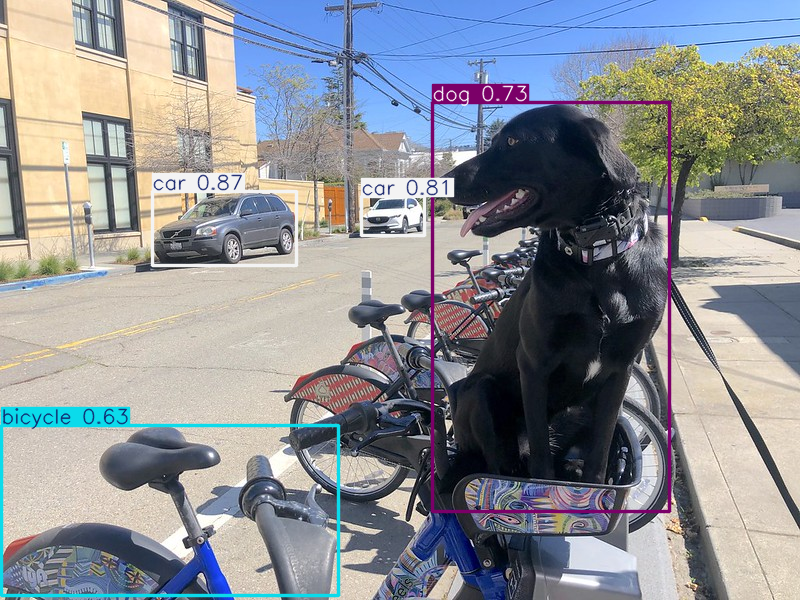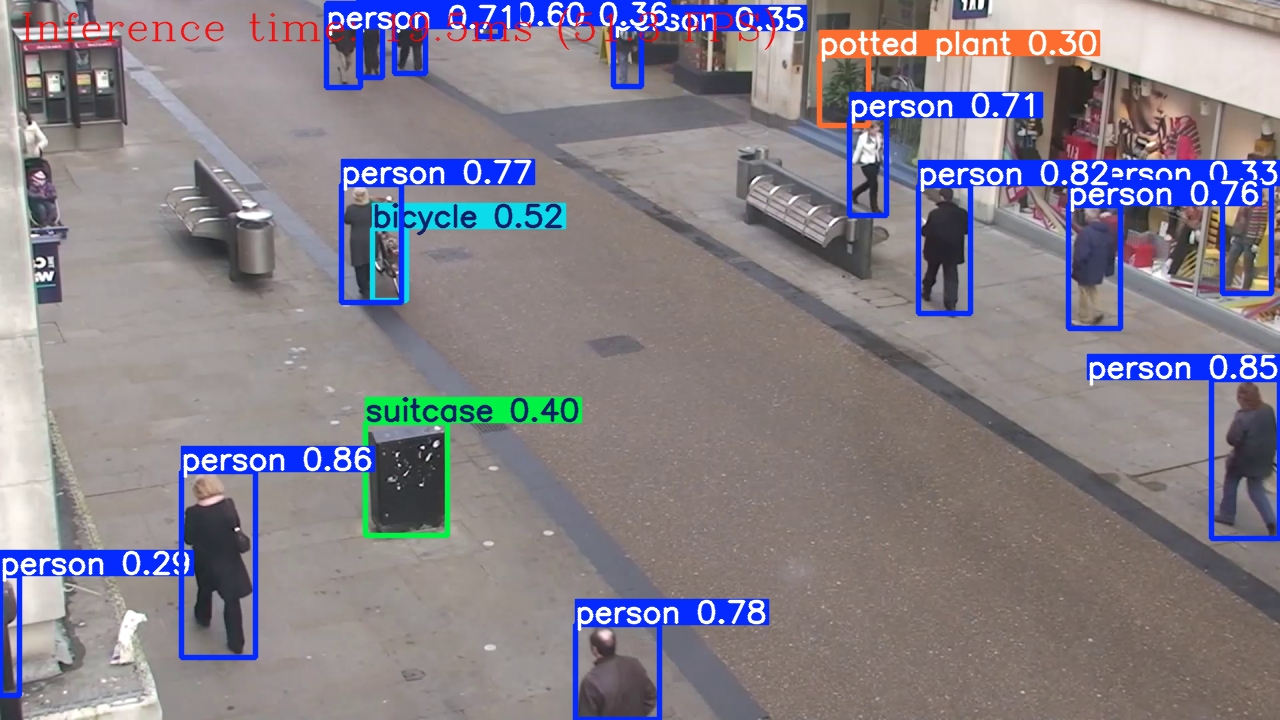Convert and Optimize YOLOv11 real-time object detection with OpenVINO™#
This Jupyter notebook can be launched on-line, opening an interactive environment in a browser window. You can also make a local installation. Choose one of the following options:
Real-time object detection is often used as a key component in computer vision systems. Applications that use real-time object detection models include video analytics, robotics, autonomous vehicles, multi-object tracking and object counting, medical image analysis, and many others.
This tutorial demonstrates step-by-step instructions on how to run and optimize PyTorch YOLOv11 with OpenVINO. We consider the steps required for object detection scenario. You can find more details about model on model page in Ultralytics documentation
The tutorial consists of the following steps: - Prepare the PyTorch model. - Download and prepare a dataset. - Validate the original model. - Convert the PyTorch model to OpenVINO IR. - Prepare and run optimization pipeline. - Compare performance of the FP32 and quantized models. - Other optimization possibilities with OpenVINO api - Live demo
Table of contents:
Installation Instructions#
This is a self-contained example that relies solely on its own code.
We recommend running the notebook in a virtual environment. You only need a Jupyter server to start. For details, please refer to Installation Guide.
Get PyTorch model#
Generally, PyTorch models represent an instance of the
torch.nn.Module
class, initialized by a state dictionary with model weights. We will use
the YOLOv11 nano model (also known as yolo11n) pre-trained on a COCO
dataset, which is available in this
repo. Similar steps are
also applicable to other YOLOv11 models. Typical steps to obtain a
pre-trained model: 1. Create an instance of a model class. 2. Load a
checkpoint state dict, which contains the pre-trained model weights. 3.
Turn the model to evaluation for switching some operations to inference
mode.
In this case, the creators of the model provide an API that enables converting the YOLOv11 model to OpenVINO IR. Therefore, we do not need to do these steps manually.
Prerequisites#
Install necessary packages.
%pip install -q "openvino>=2024.0.0" "nncf>=2.9.0"
%pip install -q "torch>=2.1" "torchvision>=0.16" "ultralytics==8.3.59" onnx tqdm opencv-python --extra-index-url https://download.pytorch.org/whl/cpu
Import required utility functions. The lower cell will download the
notebook_utils Python module from GitHub.
from pathlib import Path
import requests
if not Path("notebook_utils.py").exists():
r = requests.get(
url="https://raw.githubusercontent.com/openvinotoolkit/openvino_notebooks/latest/utils/notebook_utils.py",
)
open("notebook_utils.py", "w").write(r.text)
from notebook_utils import download_file, VideoPlayer, device_widget, quantization_widget
# Read more about telemetry collection at https://github.com/openvinotoolkit/openvino_notebooks?tab=readme-ov-file#-telemetry
from notebook_utils import collect_telemetry
collect_telemetry("yolov11-object-detection.ipynb")
# Download a test sample
IMAGE_PATH = Path("./data/coco_bike.jpg")
if not IMAGE_PATH.exists():
download_file(
url="https://storage.openvinotoolkit.org/repositories/openvino_notebooks/data/data/image/coco_bike.jpg",
filename=IMAGE_PATH.name,
directory=IMAGE_PATH.parent,
)
'data/coco_bike.jpg' already exists.
PosixPath('/home/ea/work/openvino_notebooks_new_clone/openvino_notebooks/notebooks/yolov11-optimization/data/coco_bike.jpg')
Instantiate model#
There are several models available in the original repository, targeted for different tasks. For loading the model, required to specify a path to the model checkpoint. It can be some local path or name available on models hub (in this case model checkpoint will be downloaded automatically).
You can select one of represented model using widget bellow:
import ipywidgets as widgets
model_id = ["yolo11n", "yolo11s", "yolo11m", "yolo11l", "yolo11x", "yolov8n", "yolov8s", "yolov8m", "yolov8l", "yolov8x"]
model_name = widgets.Dropdown(options=model_id, value=model_id[0], description="Model")
model_name
Dropdown(description='Model', options=('yolo11n', 'yolo11s', 'yolo11m', 'yolo11l', 'yolo11x', 'yolov8n', 'yolo…
Making prediction, the model accepts a path to input image and returns
list with Results class object. Results contains boxes for object
detection model. Also it contains utilities for processing results, for
example, plot() method for drawing.
Let us consider the examples:
from PIL import Image
from ultralytics import YOLO
DET_MODEL_NAME = model_name.value
det_model = YOLO(f"{DET_MODEL_NAME}.pt")
det_model.to("cpu")
label_map = det_model.model.names
res = det_model(IMAGE_PATH)
Image.fromarray(res[0].plot()[:, :, ::-1])
image 1/1 /home/ea/work/openvino_notebooks_new_clone/openvino_notebooks/notebooks/yolov11-optimization/data/coco_bike.jpg: 480x640 2 bicycles, 2 cars, 2 dogs, 102.3ms
Speed: 3.0ms preprocess, 102.3ms inference, 1.3ms postprocess per image at shape (1, 3, 480, 640)

Convert model to OpenVINO IR#
Ultralytics provides API for convenient model exporting to different
formats including OpenVINO IR. model.export is responsible for model
conversion. We need to specify the format, and additionally, we can
preserve dynamic shapes in the model.
# object detection model
det_model_path = Path(f"{DET_MODEL_NAME}_openvino_model/{DET_MODEL_NAME}.xml")
if not det_model_path.exists():
det_model.export(format="openvino", dynamic=True, half=True)
Verify model inference#
We can reuse the base model pipeline for pre- and postprocessing just replacing the inference method where we will use the IR model for inference.
Select inference device#
Select device from dropdown list for running inference using OpenVINO
device = device_widget()
device
Dropdown(description='Device:', index=1, options=('CPU', 'AUTO'), value='AUTO')
Test on single image#
Now, once we have defined preprocessing and postprocessing steps, we are ready to check model prediction for object detection.
import openvino as ov
core = ov.Core()
det_ov_model = core.read_model(det_model_path)
ov_config = {}
if device.value != "CPU":
det_ov_model.reshape({0: [1, 3, 640, 640]})
if "GPU" in device.value or ("AUTO" in device.value and "GPU" in core.available_devices):
ov_config = {"GPU_DISABLE_WINOGRAD_CONVOLUTION": "YES"}
det_compiled_model = core.compile_model(det_ov_model, device.value, ov_config)
det_model = YOLO(det_model_path.parent, task="detect")
if det_model.predictor is None:
custom = {"conf": 0.25, "batch": 1, "save": False, "mode": "predict"} # method defaults
args = {**det_model.overrides, **custom}
det_model.predictor = det_model._smart_load("predictor")(overrides=args, _callbacks=det_model.callbacks)
det_model.predictor.setup_model(model=det_model.model)
det_model.predictor.model.ov_compiled_model = det_compiled_model
res = det_model(IMAGE_PATH)
Image.fromarray(res[0].plot()[:, :, ::-1])
Ultralytics 8.3.0 🚀 Python-3.8.10 torch-2.4.1+cu121 CUDA:0 (NVIDIA GeForce RTX 3090, 24250MiB)
Loading yolo11n_openvino_model for OpenVINO inference...
Using OpenVINO LATENCY mode for batch=1 inference...
image 1/1 /home/ea/work/openvino_notebooks_new_clone/openvino_notebooks/notebooks/yolov11-optimization/data/coco_bike.jpg: 640x640 1 bicycle, 2 cars, 1 dog, 18.2ms
Speed: 3.3ms preprocess, 18.2ms inference, 1.4ms postprocess per image at shape (1, 3, 640, 640)

Optimize model using NNCF Post-training Quantization API#
NNCF provides a suite of advanced algorithms for Neural Networks inference optimization in OpenVINO with minimal accuracy drop. We will use 8-bit quantization in post-training mode (without the fine-tuning pipeline) to optimize model.
The optimization process contains the following steps:
Create a Dataset for quantization.
Run
nncf.quantizefor getting an optimized model.Serialize OpenVINO IR model, using the
openvino.runtime.serializefunction.
Please select below whether you would like to run quantization to improve model inference speed.
int8_model_det_path = Path(f"{DET_MODEL_NAME}_openvino_int8_model/{DET_MODEL_NAME}.xml")
quantized_det_model = None
to_quantize = quantization_widget()
to_quantize
Checkbox(value=True, description='Quantization')
Let’s load skip magic extension to skip quantization if
to_quantize is not selected
if not Path("skip_kernel_extension.py").exists():
r = requests.get(
url="https://raw.githubusercontent.com/openvinotoolkit/openvino_notebooks/latest/utils/skip_kernel_extension.py",
)
open("skip_kernel_extension.py", "w").write(r.text)
%load_ext skip_kernel_extension
%%skip not $to_quantize.value
from ultralytics.utils import DEFAULT_CFG
from ultralytics.cfg import get_cfg
from ultralytics.data.converter import coco80_to_coco91_class
from ultralytics.data.utils import check_det_dataset
from zipfile import ZipFile
from ultralytics.data.utils import DATASETS_DIR
DATA_URL = "http://images.cocodataset.org/zips/val2017.zip"
LABELS_URL = "https://github.com/ultralytics/yolov5/releases/download/v1.0/coco2017labels-segments.zip"
CFG_URL = "https://raw.githubusercontent.com/ultralytics/ultralytics/v8.1.0/ultralytics/cfg/datasets/coco.yaml"
OUT_DIR = DATASETS_DIR
DATA_PATH = OUT_DIR / "val2017.zip"
LABELS_PATH = OUT_DIR / "coco2017labels-segments.zip"
CFG_PATH = OUT_DIR / "coco.yaml"
if not int8_model_det_path.exists():
if not (OUT_DIR / "coco/labels").exists():
download_file(DATA_URL, DATA_PATH.name, DATA_PATH.parent)
download_file(LABELS_URL, LABELS_PATH.name, LABELS_PATH.parent)
download_file(CFG_URL, CFG_PATH.name, CFG_PATH.parent)
with ZipFile(LABELS_PATH, "r") as zip_ref:
zip_ref.extractall(OUT_DIR)
with ZipFile(DATA_PATH, "r") as zip_ref:
zip_ref.extractall(OUT_DIR / "coco/images")
args = get_cfg(cfg=DEFAULT_CFG)
args.data = str(CFG_PATH)
det_validator = det_model.task_map[det_model.task]["validator"](args=args)
det_validator.data = check_det_dataset(args.data)
det_validator.stride = 32
det_data_loader = det_validator.get_dataloader(OUT_DIR / "coco", 1)
det_validator.is_coco = True
det_validator.class_map = coco80_to_coco91_class()
det_validator.names = label_map
det_validator.metrics.names = det_validator.names
det_validator.nc = 80
Reuse validation dataloader in accuracy testing for quantization. For
that, it should be wrapped into the nncf.Dataset object and define a
transformation function for getting only input tensors.
%%skip not $to_quantize.value
import nncf
from typing import Dict
if not int8_model_det_path.exists():
def transform_fn(data_item:Dict):
"""
Quantization transform function. Extracts and preprocess input data from dataloader item for quantization.
Parameters:
data_item: Dict with data item produced by DataLoader during iteration
Returns:
input_tensor: Input data for quantization
"""
input_tensor = det_validator.preprocess(data_item)['img'].numpy()
return input_tensor
quantization_dataset = nncf.Dataset(det_data_loader, transform_fn)
INFO:nncf:NNCF initialized successfully. Supported frameworks detected: torch, tensorflow, onnx, openvino
The nncf.quantize function provides an interface for model
quantization. It requires an instance of the OpenVINO Model and
quantization dataset. Optionally, some additional parameters for the
configuration quantization process (number of samples for quantization,
preset, ignored scope, etc.) can be provided. Ultralytics modes contain
non-ReLU activation functions, which require asymmetric quantization of
activations. To achieve a better result, we will use a mixed
quantization preset. It provides symmetric quantization of weights and
asymmetric quantization of activations. For more accurate results, we
should keep the operation in the postprocessing subgraph in floating
point precision, using the ignored_scope parameter.
Note: Model post-training quantization is time-consuming process. Be patient, it can take several minutes depending on your hardware.
%%skip not $to_quantize.value
if not int8_model_det_path.exists():
ignored_scope = nncf.IgnoredScope( # post-processing
subgraphs=[
nncf.Subgraph(inputs=[f"__module.model.{22 if 'v8' in DET_MODEL_NAME else 23}/aten::cat/Concat",
f"__module.model.{22 if 'v8' in DET_MODEL_NAME else 23}/aten::cat/Concat_1",
f"__module.model.{22 if 'v8' in DET_MODEL_NAME else 23}/aten::cat/Concat_2"],
outputs=[f"__module.model.{22 if 'v8' in DET_MODEL_NAME else 23}/aten::cat/Concat_7"])
]
)
# Detection model
quantized_det_model = nncf.quantize(
det_ov_model,
quantization_dataset,
preset=nncf.QuantizationPreset.MIXED,
ignored_scope=ignored_scope
)
print(f"Quantized detection model will be saved to {int8_model_det_path}")
ov.save_model(quantized_det_model, str(int8_model_det_path))
Validate Quantized model inference#
nncf.quantize returns the OpenVINO Model class instance, which is
suitable for loading on a device for making predictions. INT8 model
input data and output result formats have no difference from the
floating point model representation. Therefore, we can reuse the same
detect function defined above for getting the INT8 model result
on the image.
%%skip not $to_quantize.value
device
%%skip not $to_quantize.value
if quantized_det_model is None and int8_model_det_path.exists():
quantized_det_model = core.read_model(int8_model_det_path)
ov_config = {}
if device.value != "CPU":
quantized_det_model.reshape({0: [1, 3, 640, 640]})
if "GPU" in device.value or ("AUTO" in device.value and "GPU" in core.available_devices):
ov_config = {"GPU_DISABLE_WINOGRAD_CONVOLUTION": "YES"}
quantized_det_compiled_model = core.compile_model(quantized_det_model, device.value, ov_config)
if det_model.predictor is None:
custom = {"conf": 0.25, "batch": 1, "save": False, "mode": "predict"} # method defaults
args = {**det_model.overrides, **custom}
det_model.predictor = det_model._smart_load("predictor")(overrides=args, _callbacks=det_model.callbacks)
det_model.predictor.setup_model(model=det_model.model)
det_model.predictor.model.ov_compiled_model = det_compiled_model
res = det_model(IMAGE_PATH)
display(Image.fromarray(res[0].plot()[:, :, ::-1]))
image 1/1 /home/ea/work/openvino_notebooks_new_clone/openvino_notebooks/notebooks/yolov11-optimization/data/coco_bike.jpg: 640x640 1 bicycle, 2 cars, 1 dog, 14.2ms
Speed: 3.6ms preprocess, 14.2ms inference, 1.3ms postprocess per image at shape (1, 3, 640, 640)

Compare the Original and Quantized Models#
Compare performance object detection models#
Finally, use the OpenVINO Benchmark
Tool
to measure the inference performance of the FP32 and INT8
models.
Note: For more accurate performance, it is recommended to run
benchmark_appin a terminal/command prompt after closing other applications. Runbenchmark_app -m <model_path> -d CPU -shape "<input_shape>"to benchmark async inference on CPU on specific input data shape for one minute. ChangeCPUtoGPUto benchmark on GPU. Runbenchmark_app --helpto see an overview of all command-line options.
%%skip not $to_quantize.value
device
if int8_model_det_path.exists():
# Inference FP32 model (OpenVINO IR)
!benchmark_app -m $det_model_path -d $device.value -api async -shape "[1,3,640,640]" -t 15
[Step 1/11] Parsing and validating input arguments [ INFO ] Parsing input parameters [Step 2/11] Loading OpenVINO Runtime [ WARNING ] Default duration 120 seconds is used for unknown device AUTO [ INFO ] OpenVINO: [ INFO ] Build ................................. 2024.5.0-16814-e1c167a841c [ INFO ] [ INFO ] Device info: [ INFO ] AUTO [ INFO ] Build ................................. 2024.5.0-16814-e1c167a841c [ INFO ] [ INFO ] [Step 3/11] Setting device configuration [ WARNING ] Performance hint was not explicitly specified in command line. Device(AUTO) performance hint will be set to PerformanceMode.THROUGHPUT. [Step 4/11] Reading model files [ INFO ] Loading model files [ INFO ] Read model took 20.65 ms [ INFO ] Original model I/O parameters: [ INFO ] Model inputs: [ INFO ] x (node: x) : f32 / [...] / [?,3,?,?] [ INFO ] Model outputs: [ INFO ] *NO_NAME* (node: __module.model.23/aten::cat/Concat_7) : f32 / [...] / [?,84,21..] [Step 5/11] Resizing model to match image sizes and given batch [ INFO ] Model batch size: 1 [ INFO ] Reshaping model: 'x': [1,3,640,640] [ INFO ] Reshape model took 8.77 ms [Step 6/11] Configuring input of the model [ INFO ] Model inputs: [ INFO ] x (node: x) : u8 / [N,C,H,W] / [1,3,640,640] [ INFO ] Model outputs: [ INFO ] *NO_NAME* (node: __module.model.23/aten::cat/Concat_7) : f32 / [...] / [1,84,8400] [Step 7/11] Loading the model to the device [ INFO ] Compile model took 524.58 ms [Step 8/11] Querying optimal runtime parameters [ INFO ] Model: [ INFO ] NETWORK_NAME: Model0 [ INFO ] EXECUTION_DEVICES: ['CPU'] [ INFO ] PERFORMANCE_HINT: PerformanceMode.THROUGHPUT [ INFO ] OPTIMAL_NUMBER_OF_INFER_REQUESTS: 12 [ INFO ] MULTI_DEVICE_PRIORITIES: CPU [ INFO ] CPU: [ INFO ] AFFINITY: Affinity.CORE [ INFO ] CPU_DENORMALS_OPTIMIZATION: False [ INFO ] CPU_SPARSE_WEIGHTS_DECOMPRESSION_RATE: 1.0 [ INFO ] DYNAMIC_QUANTIZATION_GROUP_SIZE: 32 [ INFO ] ENABLE_CPU_PINNING: True [ INFO ] ENABLE_HYPER_THREADING: True [ INFO ] EXECUTION_DEVICES: ['CPU'] [ INFO ] EXECUTION_MODE_HINT: ExecutionMode.PERFORMANCE [ INFO ] INFERENCE_NUM_THREADS: 36 [ INFO ] INFERENCE_PRECISION_HINT: <Type: 'float32'> [ INFO ] KV_CACHE_PRECISION: <Type: 'float16'> [ INFO ] LOG_LEVEL: Level.NO [ INFO ] MODEL_DISTRIBUTION_POLICY: set() [ INFO ] NETWORK_NAME: Model0 [ INFO ] NUM_STREAMS: 12 [ INFO ] OPTIMAL_NUMBER_OF_INFER_REQUESTS: 12 [ INFO ] PERFORMANCE_HINT: THROUGHPUT [ INFO ] PERFORMANCE_HINT_NUM_REQUESTS: 0 [ INFO ] PERF_COUNT: NO [ INFO ] SCHEDULING_CORE_TYPE: SchedulingCoreType.ANY_CORE [ INFO ] MODEL_PRIORITY: Priority.MEDIUM [ INFO ] LOADED_FROM_CACHE: False [ INFO ] PERF_COUNT: False [Step 9/11] Creating infer requests and preparing input tensors [ WARNING ] No input files were given for input 'x'!. This input will be filled with random values! [ INFO ] Fill input 'x' with random values [Step 10/11] Measuring performance (Start inference asynchronously, 12 inference requests, limits: 120000 ms duration) [ INFO ] Benchmarking in inference only mode (inputs filling are not included in measurement loop). [ INFO ] First inference took 29.31 ms [Step 11/11] Dumping statistics report [ INFO ] Execution Devices:['CPU'] [ INFO ] Count: 20040 iterations [ INFO ] Duration: 120081.07 ms [ INFO ] Latency: [ INFO ] Median: 68.90 ms [ INFO ] Average: 71.71 ms [ INFO ] Min: 47.48 ms [ INFO ] Max: 162.55 ms [ INFO ] Throughput: 166.89 FPS
if int8_model_det_path.exists():
# Inference INT8 model (OpenVINO IR)
!benchmark_app -m $int8_model_det_path -d $device.value -api async -shape "[1,3,640,640]" -t 15
[Step 1/11] Parsing and validating input arguments [ INFO ] Parsing input parameters [Step 2/11] Loading OpenVINO Runtime [ INFO ] OpenVINO: [ INFO ] Build ................................. 2024.5.0-16814-e1c167a841c [ INFO ] [ INFO ] Device info: [ INFO ] AUTO [ INFO ] Build ................................. 2024.5.0-16814-e1c167a841c [ INFO ] [ INFO ] [Step 3/11] Setting device configuration [ WARNING ] Performance hint was not explicitly specified in command line. Device(AUTO) performance hint will be set to PerformanceMode.THROUGHPUT. [Step 4/11] Reading model files [ INFO ] Loading model files [ INFO ] Read model took 31.70 ms [ INFO ] Original model I/O parameters: [ INFO ] Model inputs: [ INFO ] x (node: x) : f32 / [...] / [1,3,640,640] [ INFO ] Model outputs: [ INFO ] *NO_NAME* (node: __module.model.23/aten::cat/Concat_7) : f32 / [...] / [1,84,8400] [Step 5/11] Resizing model to match image sizes and given batch [ INFO ] Model batch size: 1 [ INFO ] Reshaping model: 'x': [1,3,640,640] [ INFO ] Reshape model took 0.05 ms [Step 6/11] Configuring input of the model [ INFO ] Model inputs: [ INFO ] x (node: x) : u8 / [N,C,H,W] / [1,3,640,640] [ INFO ] Model outputs: [ INFO ] *NO_NAME* (node: __module.model.23/aten::cat/Concat_7) : f32 / [...] / [1,84,8400] [Step 7/11] Loading the model to the device [ INFO ] Compile model took 729.93 ms [Step 8/11] Querying optimal runtime parameters [ INFO ] Model: [ INFO ] NETWORK_NAME: Model0 [ INFO ] EXECUTION_DEVICES: ['CPU'] [ INFO ] PERFORMANCE_HINT: PerformanceMode.THROUGHPUT [ INFO ] OPTIMAL_NUMBER_OF_INFER_REQUESTS: 18 [ INFO ] MULTI_DEVICE_PRIORITIES: CPU [ INFO ] CPU: [ INFO ] AFFINITY: Affinity.CORE [ INFO ] CPU_DENORMALS_OPTIMIZATION: False [ INFO ] CPU_SPARSE_WEIGHTS_DECOMPRESSION_RATE: 1.0 [ INFO ] DYNAMIC_QUANTIZATION_GROUP_SIZE: 32 [ INFO ] ENABLE_CPU_PINNING: True [ INFO ] ENABLE_HYPER_THREADING: True [ INFO ] EXECUTION_DEVICES: ['CPU'] [ INFO ] EXECUTION_MODE_HINT: ExecutionMode.PERFORMANCE [ INFO ] INFERENCE_NUM_THREADS: 36 [ INFO ] INFERENCE_PRECISION_HINT: <Type: 'float32'> [ INFO ] KV_CACHE_PRECISION: <Type: 'float16'> [ INFO ] LOG_LEVEL: Level.NO [ INFO ] MODEL_DISTRIBUTION_POLICY: set() [ INFO ] NETWORK_NAME: Model0 [ INFO ] NUM_STREAMS: 18 [ INFO ] OPTIMAL_NUMBER_OF_INFER_REQUESTS: 18 [ INFO ] PERFORMANCE_HINT: THROUGHPUT [ INFO ] PERFORMANCE_HINT_NUM_REQUESTS: 0 [ INFO ] PERF_COUNT: NO [ INFO ] SCHEDULING_CORE_TYPE: SchedulingCoreType.ANY_CORE [ INFO ] MODEL_PRIORITY: Priority.MEDIUM [ INFO ] LOADED_FROM_CACHE: False [ INFO ] PERF_COUNT: False [Step 9/11] Creating infer requests and preparing input tensors [ WARNING ] No input files were given for input 'x'!. This input will be filled with random values! [ INFO ] Fill input 'x' with random values [Step 10/11] Measuring performance (Start inference asynchronously, 18 inference requests, limits: 15000 ms duration) [ INFO ] Benchmarking in inference only mode (inputs filling are not included in measurement loop). [ INFO ] First inference took 22.63 ms [Step 11/11] Dumping statistics report [ INFO ] Execution Devices:['CPU'] [ INFO ] Count: 6210 iterations [ INFO ] Duration: 15054.55 ms [ INFO ] Latency: [ INFO ] Median: 41.05 ms [ INFO ] Average: 43.44 ms [ INFO ] Min: 31.34 ms [ INFO ] Max: 112.15 ms [ INFO ] Throughput: 412.50 FPS
Next steps#
This section contains suggestions on how to additionally improve the performance of your application using OpenVINO.
Async inference pipeline#
The key advantage of the Async API is that when a device is busy with inference, the application can perform other tasks in parallel (for example, populating inputs or scheduling other requests) rather than wait for the current inference to complete first. To understand how to perform async inference using openvino, refer to Async API tutorial
Live demo#
The following code runs model inference on a video:
import collections
import time
from IPython import display
import cv2
import numpy as np
# Main processing function to run object detection.
def run_object_detection(
source=0,
flip=False,
use_popup=False,
skip_first_frames=0,
model=det_model,
device=device.value,
video_width: int = None, # if not set the original size is used
):
player = None
ov_config = {}
if device != "CPU":
model.reshape({0: [1, 3, 640, 640]})
if "GPU" in device or ("AUTO" in device and "GPU" in core.available_devices):
ov_config = {"GPU_DISABLE_WINOGRAD_CONVOLUTION": "YES"}
compiled_model = core.compile_model(model, device, ov_config)
if det_model.predictor is None:
custom = {"conf": 0.25, "batch": 1, "save": False, "mode": "predict"} # method defaults
args = {**det_model.overrides, **custom}
det_model.predictor = det_model._smart_load("predictor")(overrides=args, _callbacks=det_model.callbacks)
det_model.predictor.setup_model(model=det_model.model)
det_model.predictor.model.ov_compiled_model = compiled_model
try:
# Create a video player to play with target fps.
player = VideoPlayer(source=source, flip=flip, fps=30, skip_first_frames=skip_first_frames)
# Start capturing.
player.start()
if use_popup:
title = "Press ESC to Exit"
cv2.namedWindow(winname=title, flags=cv2.WINDOW_GUI_NORMAL | cv2.WINDOW_AUTOSIZE)
processing_times = collections.deque()
while True:
# Grab the frame.
frame = player.next()
if frame is None:
print("Source ended")
break
if video_width:
# If the frame is larger than video_width, reduce size to improve the performance.
# If more, increase size for better demo expirience.
scale = video_width / max(frame.shape)
frame = cv2.resize(
src=frame,
dsize=None,
fx=scale,
fy=scale,
interpolation=cv2.INTER_AREA,
)
# Get the results.
input_image = np.array(frame)
start_time = time.time()
detections = det_model(input_image, verbose=False)
stop_time = time.time()
frame = detections[0].plot()
processing_times.append(stop_time - start_time)
# Use processing times from last 200 frames.
if len(processing_times) > 200:
processing_times.popleft()
_, f_width = frame.shape[:2]
# Mean processing time [ms].
processing_time = np.mean(processing_times) * 1000
fps = 1000 / processing_time
cv2.putText(
img=frame,
text=f"Inference time: {processing_time:.1f}ms ({fps:.1f} FPS)",
org=(20, 40),
fontFace=cv2.FONT_HERSHEY_COMPLEX,
fontScale=f_width / 1000,
color=(0, 0, 255),
thickness=1,
lineType=cv2.LINE_AA,
)
# Use this workaround if there is flickering.
if use_popup:
cv2.imshow(winname=title, mat=frame)
key = cv2.waitKey(1)
# escape = 27
if key == 27:
break
else:
# Encode numpy array to jpg.
_, encoded_img = cv2.imencode(ext=".jpg", img=frame, params=[cv2.IMWRITE_JPEG_QUALITY, 100])
# Create an IPython image.
i = display.Image(data=encoded_img)
# Display the image in this notebook.
display.clear_output(wait=True)
display.display(i)
# ctrl-c
except KeyboardInterrupt:
print("Interrupted")
# any different error
except RuntimeError as e:
print(e)
finally:
if player is not None:
# Stop capturing.
player.stop()
if use_popup:
cv2.destroyAllWindows()
Run Live Object Detection#
Use a webcam as the video input. By default, the primary webcam is set
with source=0. If you have multiple webcams, each one will be
assigned a consecutive number starting at 0. Set flip=True when
using a front-facing camera. Some web browsers, especially Mozilla
Firefox, may cause flickering. If you experience flickering,
set use_popup=True.
NOTE: To use this notebook with a webcam, you need to run the notebook on a computer with a webcam. If you run the notebook on a remote server (for example, in Binder or Google Colab service), the webcam will not work. By default, the lower cell will run model inference on a video file. If you want to try live inference on your webcam set
WEBCAM_INFERENCE = True
Run the object detection:
WEBCAM_INFERENCE = False
if WEBCAM_INFERENCE:
VIDEO_SOURCE = 0 # Webcam
else:
VIDEO_SOURCE = "people.mp4"
if not Path(VIDEO_SOURCE).exists():
download_file(
"https://storage.openvinotoolkit.org/repositories/openvino_notebooks/data/data/video/people.mp4",
"people.mp4",
)
device
Dropdown(description='Device:', index=1, options=('CPU', 'AUTO'), value='AUTO')
run_object_detection(
source=VIDEO_SOURCE,
flip=True,
use_popup=False,
model=det_ov_model,
device=device.value,
# video_width=1280,
)

Source ended